The most visible elements of the winning proposal are the new cube ((with three temporary exhibition rooms measuring 30 meters by 12 and 6 meters high; and also an interior patio where you can see the apse of the church and the façade of the old convent) ) to be built in one of the corners of Plaça del Àngels and the new façade with large brick pillars that runs along the side of the Convent dels Àngels. The new arcade unifies the façade of the new building with the old buildings and dialogues, opposite the façade of the white MACBA designed by Richard Meier in 1995. According to the jury made up of 21 independent experts, it was the proposal that best resolved the relationship between different existing buildings around the square:
‘A proposal that neatly resolves the dialogue on three different scales:with the neighbourhood, the city and the Museum’
With this action, the museum will gain about 3,000 m², while allowing the Capella and Convent dels Àngels spaces to be adapted as exhibition spaces. The project is part of MACBA's "2022 Strategy" for the reorganization and improvement of museum spaces and services. In this way, MACBA will be able to display in all its power a Collection that has been growing continuously for 25 years, which currently has almost 6,000 pieces and which has become an international benchmark.
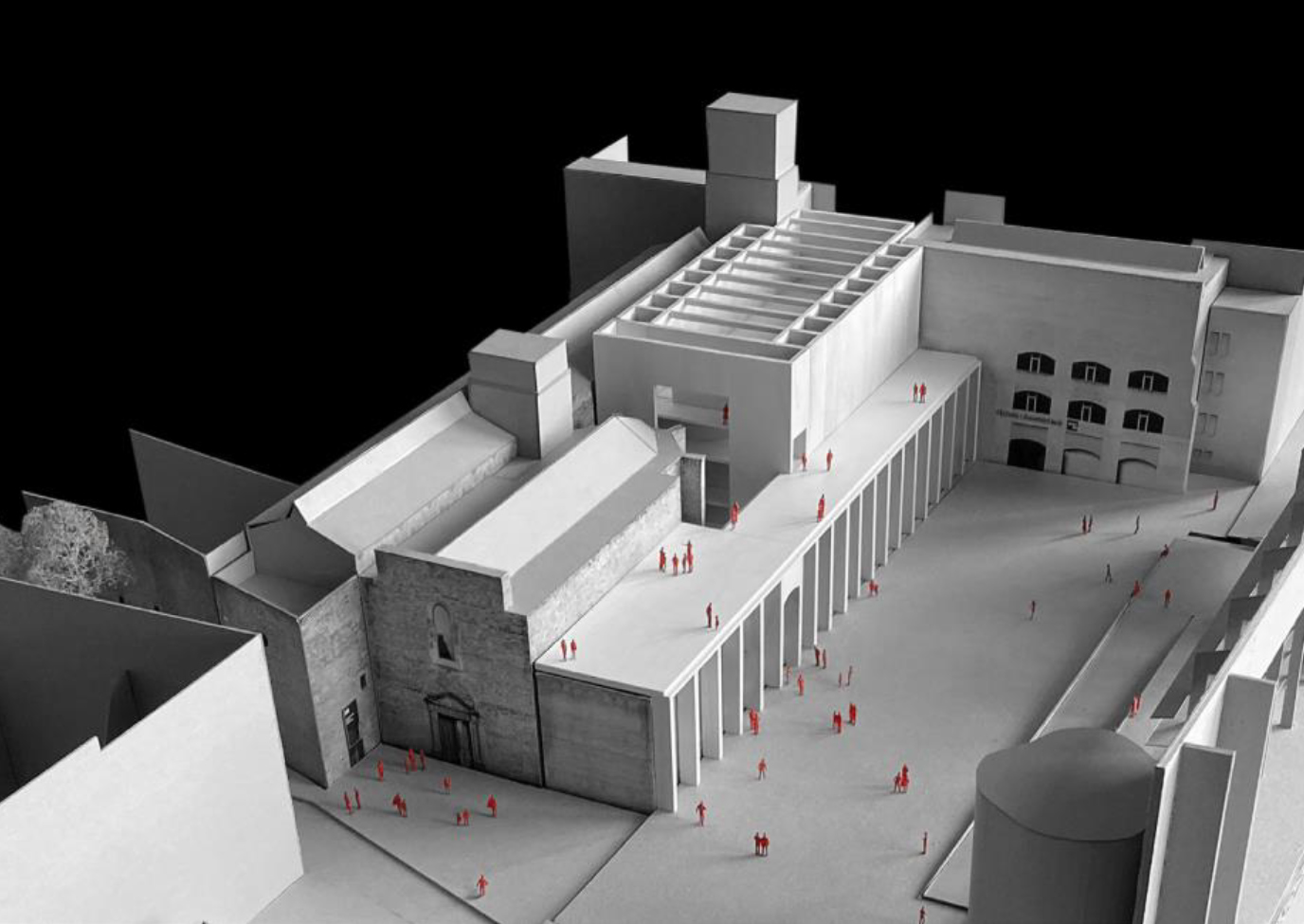
Description of project by HArquitectes and Christ & Gantenbein
THE NEW MACBA AND THE CITY
A new syntax
MACBA’s new extension is situated in a particularly complex context. The need to expand the Museum could easily compromise the existing buildings on the site and their history. The heritage value of the Convent dels Àngels and the subsequent interventions of Clotet-Paricio have created an environment where it is unclear how best to intervene. The answer requires a broad vision that transcends partial points of view: to build an additional layer over the existing structure that reformulates new relationships between the present ensemble, the Plaça dels Angels and the Meier building. A new syntax for the site is required.
From the Liceu to the Seminary
We want to situate our proposal within the context of the Raval district from the perspective of the project that Clotet and Tusquets developed in the 1980s with the aim of revitalising its central area. A project to enhance, articulate and expand the existing gaps, based on the recognition of the structure of courtyards and cloisters of the old convents that once characterised the neighbourhood. Plaça dels Àngels is the most radical and central element of this project.
Connecting the two squares
The access passage that currently connects Plaça dels Àngels and Plaça de les Caramelles was initially part of this project. But it is too narrow, long and residual, resulting in an urban corner of poor quality, always problematic and currently closed. The construction of the new building could actually accentuate and perpetuate this ‘problem’. A more realistic and efficient alternative must be sought: one that uses the Museum itself as a public access passage from one area to the other.
New entrance through the chapel
We are convinced that the convent’s Renaissance chapel has neither the scale nor sufficient size to function as the main access to MACBA. A larger and more emblematic space is needed to ensure the necessary transition between the public space and the Museum. The convent’s chapel will become the new entrance hall to the Museum, a very special space, with free access open to everyone. The door of the chapel, completely aligned with and facing Carrer Elisabets, will be the new entrance to the Museum, receiving the influx of visitors arriving from the Rambla.
THE CHAPEL AND THE TRANSEPT
Access through the transept
We propose to take advantage of the cross floorplan of the chapel to connect Carrer Elisabets and the two squares, thus solving (in a single space) the flow of visitors envisioned by the project. By extending to ground level the existing openings in the arms of the transept, two new points of access will be created. This new access passage will only be open during Museum hours but it will offer a (public) alternative for moving between squares that is more congenial, safer and practical than the current one. The transept can become the access passage that Clotet and Tusquets envisaged.
Moving the centre of gravity
The transformation of the chapel into a hall (the 'Turbine Hall' of MACBA) and urban connector gives it an additional prominence that suggests that this new entrance could become the main access to the Museum (or duplicate that of the Meier building). Concentrating the public access passage and the hall in a single space allows the centre of gravity of the Museum and the square to be moved to the chapel. A new centrality perfectly aligned to Carrer Elisabets.
Scale of the square – Human scale
With this project, the difficulty lies in finding the right scale of intervention and balancing the different elements. The scale of the heritage, the scale of the Museum, the scale of the square and the human scale. In the aspect that faces the square, instead of utilising the building’s entire height, we propose to reduce the height in favour of the length by means of a low and long structure that preserves and integrates the buttresses of Clotet-Paricio. The length and permeability of this lower structure will ensure a strong link between the square and the Museum, while both relating it to the Meier building and to the scale of the square. The gallery will create an urban step in the form of a large (exhibition) terrace, lending the Museum a more domestic and affable dimension.
SQUARE ON THREE LEVELS
Redefining the institution
The human scale of this plinth is what redefines the institution, making it more accessible and approachable. The (new) MACBA will cease to be a Museum that imposes itself and become a Museum that participates in and interacts with the public space.
Square on three levels
The new terrace above the plinth will establish a strong dialogue with the square and especially with the base of the Meier building. This is a public space that unfolds and climbs to the terrace of the Museum, in which the structure of the chapel, the new exhibition gallery and the Meier building form the backdrop of a new square on three levels. Stepping the level of the building also ensures an increase to winter sunshine entering the square.
Urban gallery + Art container
The low, porous structure qualifies and activates the square. It functions as an urban gallery that houses the Museum’s shop (located in the area of the converted buttresses), the entrance through the transept and a long, glazed porch that functions as a large window through which the Museum’s function as exhibition space is made evident. The apse of the chapel can be seen through the gallery from the square. Above are two taller, opaque structures: the chapel itself and the new art container that uses the full height to create three large superimposed exhibition rooms (30 x 12 x 6m).
Sewing with buttresses
All the existing buildings use structural buttresses, whose presence defines their character and identity. The repetition in different formats and materials of these buttresses unifies buildings from different historical periods. The homogeneity of these compressed mineral systems forms very unique and special spaces. We propose to build the new Museum from wall systems of large ceramic-brick buttresses that, thanks to their material and compositional strength, will sew together the different buildings into a trans-historic whole. Different materials, but the same structural and compositional logic.
ACTIVE FAÇADE
Relocating the public toilets – moving 6A – lengthening the new façade
The public toilets will be demolished and relocated to the east end of the convent building, with independent access from the street. The area classified as 6A, which occupies the structure to be demolished, will be relocated to the front of the square, thus regularising the front façade parallel to the convent and allowing new buttresses to be constructed in front of the existent buttressed building. This simple urban compensation does not compromise the plans currently being processed and may be modified under the special plan stipulated in the competition rules.
Rehabilitating the buttressed building (Clotet-Paricio)
It is important to incorporate the buttressed building into the Museum so that the entire façade facing the square is used. We propose the demolition of the middle section (which currently has no function) in order to give it the required height for a facility. We will keep the post-tensioned buttresses of the original building and reinforce them by superimposing the new façade buttresses. This operation makes it possible to place the bookshop in this space, open to the transept, while definitively consolidating the base of the new Museum as an active façade along the square.
MACBA white
Built of ceramic bricks, the buttresses of the gallery will be white faced (eastern aspect) thus linking them to the Meier building and lending them a transmutable aspect. Upon entering the square from Carrer del Àngels, a succession of white buttresses (with dynamic inscriptions using LED lights where the bricks join) momentarily transform the gallery, echoing the Meier building. In the frontal view (more in keeping with the heritage), as seen when arriving from Carrer de Ferlandina, the materiality of the traditional brick with which the whole extension is built will be maintained.
Great infrastructure
We understand the new MACBA as a coherent cultural-Museum ensemble (Meier + church, convent + extension) capable of providing a rich cultural offering and forming a new conglomerate made up of parts but conceived as a single infrastructure. The coincidence of the convent’s buttresses and the strategic placement of the emergency exits will maximise the versatility of all the convent spaces, allowing for them to be transformed over time. The new MACBA will be an urban campus, a transformable cultural infrastructure.
HERITAGE
Heritage turned into an opportunity
Building next to a heritage site is often considered a ‘problem’ or a price to be paid that will condition the new building. We propose turning difficulty into virtue by transforming the pre-existing heritage elements into an essential part of the project and the (new) Museum. Strengthening its representative character, the chapel, the apse and the façade of the old convent will become central points and, above all, the characteristics of the new Museum. Adding a new structure that extends the nature of the existing one, without denying or hiding the original building, and making the most of its value. A ‘problem’ turned into an essential part of the (new) Museum.
Adding or growing
The extension will be integrated into the pre-existing ensemble, inheriting certain constructive, compositional and volumetric logics. A new entity will be created made up of parts from different periods but with a single, and continuous, tectonic logic. Rather than being an addition, the extension will enable what is already there to grow. A revised prolongation based on the logics of the original. The new MACBA cannot be understood without the convent, the chapel and the ‘buttressed’ building of Clotet-Paricio.
Courtyard of the apse
The apse is the most expressive piece of the whole. The entire project revolves around a small cloister. A glazed outdoor courtyard surrounded by passageways and the main staircase, ensuring maximum visibility of this unique piece. Its central position in the whole ensemble and the view from the square give it maximum prominence. The new MACBA would not be what it is without the apse of the Capella de la Mare de Déu dels Àngels.
ADD OR GROW
Rooms between buttresses: The façade of the convent
The space between the large exhibition rooms and the façade of the convent is very much conditioned by the original buttresses. We propose to turn these elements into the most special and essential spaces of the Museum. We will complement the existing buttresses with new ceramic-brick buttresses (superimposed on the existing ones but with a different materiality) creating small, very high exhibition spaces with overhead light. Extraordinary and intense spaces for installing very unique pieces. The overhead light and the verticality of the spaces will emphasise the heritage, monumentalising it and offering a transcendent experience. A unique space to exhibit unique pieces.
The chapel
This will be the main space of the Museum. A new access and exhibition area. The most accessible and visited space in the new Museum. We propose to open the transept to the two squares, preserving the existing ceramic lattice holes. On the other hand, we propose to eliminate some of the interventions of the Clotet-Paricio project that, in our opinion, distort the original spirit of the chapel, and to recuperate its more basic and austere image.
Restoration criteria
We aim to restore in more detail the unique elements (chapel door, windows, etc.) and to rehabilitate the damaged finishes of the wall surfaces. Wherever possible (for example in the chapel), original walls and spatial configurations that have been altered during previous architectural interventions will be restored.
THE MUSEUM
The church as the main access
Access to the new extension of MACBA will be through the Església dels Àngels, accessed through its main door or from the Plaça dels Àngels or through the transept. The central nave of the church will be the reception and security area, and one of the entrances to the MACBA campus. The Renaissance nave will house the cloakroom services, while the side annex that housed the public toilets will be integrated into the whole of the buttressed façade and will include the bookshop.
The gallery, exhibition and façade
To the south, the transept connects the church with the rest of the ground floor of the convent and with a new exhibition courtyard beyond its façade in Plaça de les Caramelles. To the north, the transept connects with the new gallery in Plaça dels Àngels. The gallery is an iconic (and changing?) exhibition space lending its image to the city, and together with the main structure, it creates a courtyard around the apse. Above the gallery and side chapels is a large terrace with open-air sculptures, also visible from the square.
Three exhibition rooms of 31x12m
The main exhibition space houses three rooms of 31 x 12m with a height of 5.5m on the ground floor and 7m elsewhere. These are fully equipped and neutral spaces purposely designed for exhibitions. The room under the roof will have the option of using natural light.
The side rooms formed by the buttresses
On either side of the large rooms, interstices between buttresses become small spaces of double height or more. They provide very special exhibition conditions (some have overhead light), and are intended for unique works and audiovisual installations.








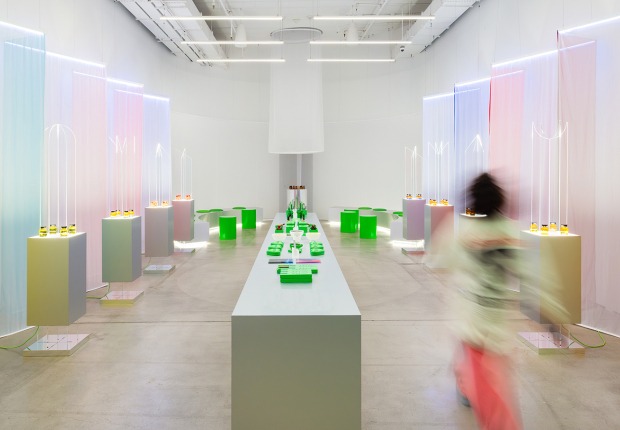
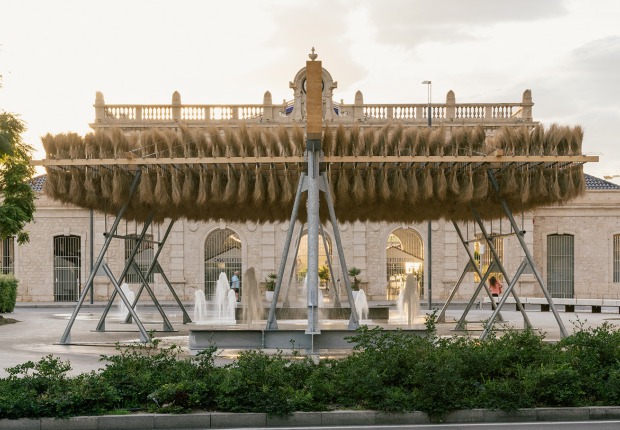
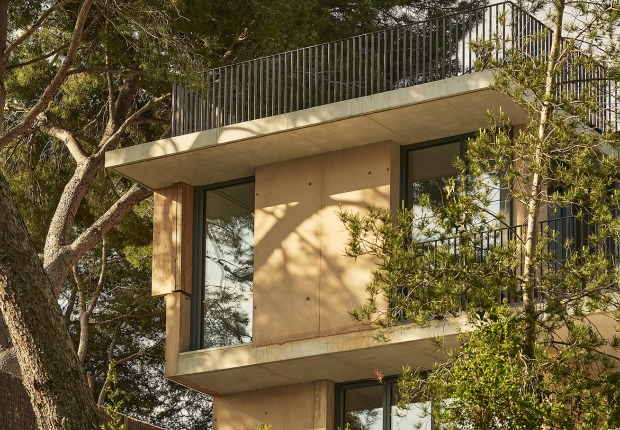






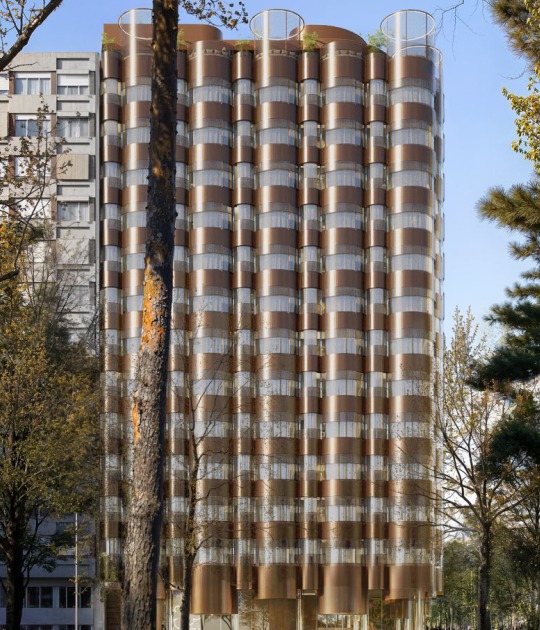


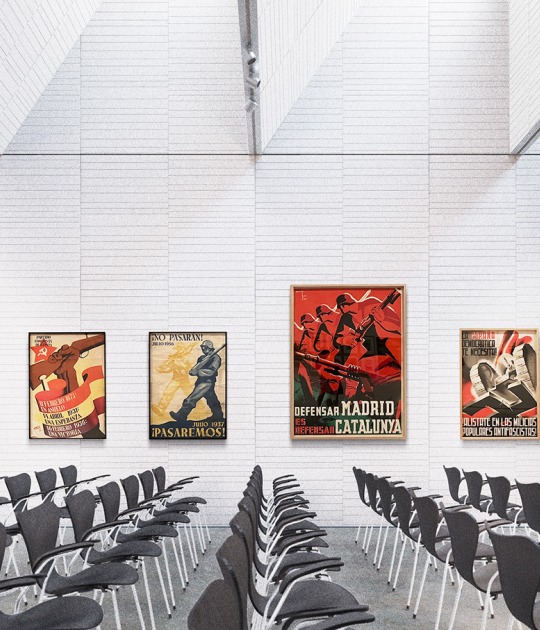

![Matta-Clark, Gordon Office Baroque, 4th Floor [Documentació de l'acció "Office Baroque" realitzada el 1977 a Anvers, Bèlgica] 1977 Fotografia a les sals de plata 25,3 x 20,3 cm Col·lecció MACBA. Fundació Museu d'Art Contemporani de Barcelona. Dipòsit Col·lecció LATA Matta-Clark, Gordon Office Baroque, 4th Floor [Documentació de l'acció "Office Baroque" realitzada el 1977 a Anvers, Bèlgica] 1977 Fotografia a les sals de plata 25,3 x 20,3 cm Col·lecció MACBA. Fundació Museu d'Art Contemporani de Barcelona. Dipòsit Col·lecció LATA](/sites/default/files/styles/mopis_home_news_category_slider_desktop/public/lead-images/ml4147_mg_8986.jpg?h=8b2a012f&itok=v0X8-j5Z)

![Gordon Matta-Clark Office Baroque [Documentation of "Office Baroque" 1977 in Anvers, Belgium] Col·lecció MACBA. Fundació MACBA. Col·lecció LATA © Estate of Gordon Matta Clark, VEGAP, Barcelona, 2012. Photography: Vanessa Miralles Gordon Matta-Clark Office Baroque [Documentation of "Office Baroque" 1977 in Anvers, Belgium] Col·lecció MACBA. Fundació MACBA. Col·lecció LATA © Estate of Gordon Matta Clark, VEGAP, Barcelona, 2012. Photography: Vanessa Miralles](/sites/default/files/styles/mopis_home_news_category_slider_desktop/public/lead-images/ml_mattaclark_01_1024_p.jpg?h=3b4e7bc7&itok=VLk9w6-z)




